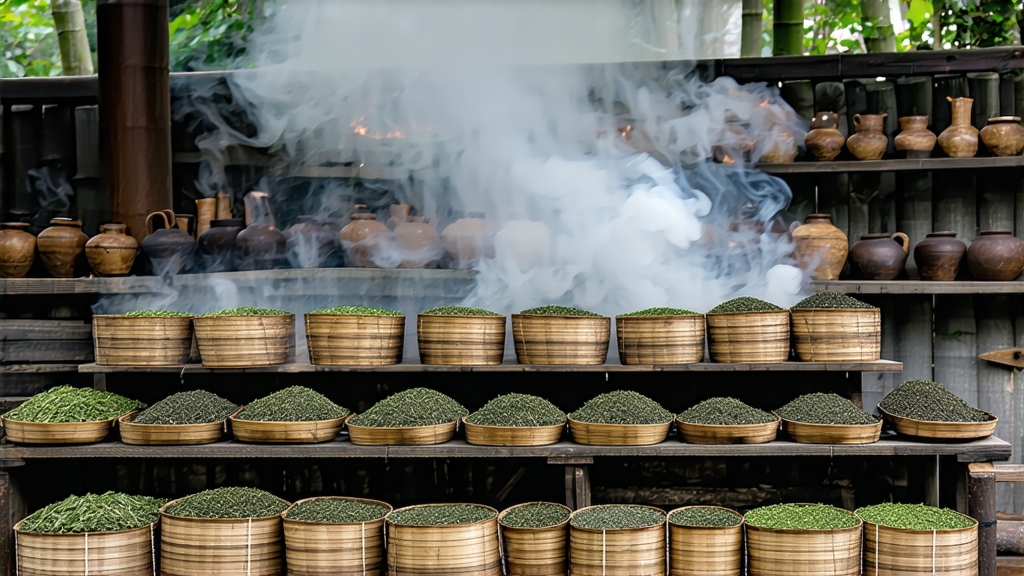
Long before English tea clippers raced across the oceans and Victorian parlors rang with the clink of porcelain, a small village deep in China’s Wuyi Mountains was already perfecting the world’s first fully oxidized tea. Locals call it Zheng Shan Xiao Zhong; the West knows it as Lapsang Souchong. Revered by tea historians as the progenitor of every black tea on earth, this pine-smoked masterpiece carries within its glossy, tar-black leaves the story of Ming-dynasty ingenuity, trans-continental trade, and the unbreakable bond between terroir and human craft.
History: From Mountain Refuge to Global Legend
The accepted chronology begins in 1646, when Qing armies poured into Fujian province. Retreating Ming loyalists, camping amid the cedar and pine forests of Tongmu Guan, hastily dried freshly plucked tea over resinous pine fires so it would travel with their baggage. The accidental infusion of woodsmoke proved delicious, and the technique lingered. By the early 1700s, Dutch and British traders anchoring at Xiamen port were buying “bohea” (the Hokkien pronunciation of Wuyi) in such volume that Lapsang Souchong became the first Chinese black tea ever documented in Europe. Samuel Pepys mentioned drinking “a cup of China tea smoked” in 1667; by 1830 it graced the breakfast table of Queen Victoria herself. The East India Company even attempted to replicate the flavor in Assam using rhododendron wood—an experiment that failed, cementing Tongmu’s mystique.
Terroir: Why Only Tongmu Can Birth Authenticity
Authentic Zheng Shan Xiao Zhong is protected by China’s National Origin Product status; the demarcated zone totals barely 120 km² of steep granite gorges at 600–1,200 m elevation. Here, a subtropical monsoon climate collides with mineral-rich soils derived from weathered volcanic tuff. Daily cloud cover shortens sunlight hours, forcing tea bushes (predominantly the small-leaf Xiao Ye Zhong cultivar) to synthesize more amino acids and less bitter catechin. The result is an inherently sweet, umami-laden leaf that can absorb smoke without turning acrid. Outside this microclimate, producers may mimic the process, but the cup lacks the honeyed depth that balances the campfire aroma.
Leaf Grades: From Souchong to Congou
Western tea catalogues often flatten Lapsang into a single smoky monolith, yet connoisseurs recognize four ascending grades, all harvested in early May:
- Leaf Souchong (third & fourth open leaves) – bold, tarry, destined for Russian samovars.
- Broken Souchong – finer cut, faster infusing, favored by European blenders for “Russian Caravan” mélanges.
- Pekoe Souchong (second leaf) – subtler smoke, cocoa notes, the grade that first captivated London ladies.
- Congou Lapsang (first leaf & bud) – the pinnacle, smoked delicately so that cocoa, longan fruit, and wet slate precede a whisper of pine.
Craft: The Eight Stages of Smoke and Fire
Plucking begins at dawn when dew still weighs down the leaf, slowing oxidation. After a brief outdoor withering on bamboo racks, leaves are moved into the upper loft of a three-story wooden house. A pine-wood fire is lit below; the rising warm air completes withering in 4–5 hours while infusing a preliminary smoke. Rolling follows—first mechanical kneading to rupture cells, then hand-rolling on rattan mats to twist leaves into tight strips. Oxidation proceeds in cedar-lined trays kept at 24 °C and 85 % humidity; the leaf gradually shifts from jade to copper. Now comes the critical smoking sequence unique to Lapsang:
- First drying (mao hong): baskets of oxidized leaf are placed on bamboo racks 1.5 m above smoldering pine logs for 2–3 minutes.
- Resting: leaves cool for 30 minutes, allowing moisture to migrate outward.
- Second drying (zu hong): temperature raised, smoking extended to 5 minutes.
- Final fragrance pass: a gentle 30-second kiss of sweet pine smoke to lock in bouquet.
Master smokers judge readiness by sound—when a handful of leaves crackles like autumn twigs yet remains pliable, the process